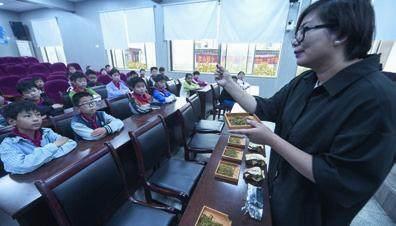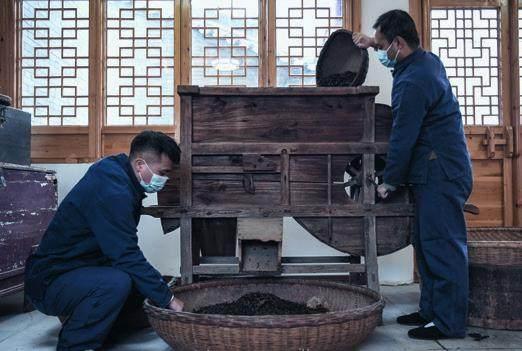A Story of Leaves
2022-05-30ByYuanYuan
By Yuan Yuan
After discovering a wonderland for tea lovers, Liu Mingchu extended his one-week stay in Zhanglang Village in Yunnan Province to more than three weeks.
The entrepreneur from Guangdong Province runs a travel agency featuring niche travel routes in China. He traveled to the village earlier this year while scouting destinations for planned tea-themed tours in the province.
He selected the village for several reasons. Nestled in a primitive forest above a valley, Zhanglang has a history of over 1,000 years. Its inhabitants, all of the Blang ethnic group, build their houses in the forest and have maintained traditional methods of growing and making tea for generations.
Hearing the news that “traditional tea processing techniques and associated social practices in China” had been inscribed onto the intangible cultural heritage list of the United Nations Educational, Scientific, and Cultural Organization (UNESCO) on November 29, Liu said the village provides a good example of how tea has long been integrated into life across China. “The village gave me a much deeper understanding of tea culture and the harmony between tea and people,” he told Beijing Review.
A tea treat
The village has almost no access to public transportation, but its isolation has allowed it to maintain much of its original culture. Locals here also continue the ancient rituals of praying to and worshiping the God of Tea.
April is tea harvest season in Zhanglang. In contrast with young people in most other rural villages in China, Zhanglangs younger generations have followed in their parents and grandparents footsteps by staying put in the village to grow and process tea. Income from tea production is more than enough to cover family expenses.
Each family works hard during harvest season, getting up early to pick leaves from their own tea gardens and returning home after dark to continue processing the tea until midnight.
By using different processing methods, the leaves from one tree can be turned into multiple categories of tea. The village mainly produces white tea and puer tea. To produce the latter, villagers need to heat the leaves in pans. This step is called shaqing, literally meaning “killing the green.” “Each April, the aroma of tea permeates the whole village,” Liu said.

The oldest tea tree in the village is over 800 years old and thousands of trees are more than 100 years old. Warm and humid Yunnan provides a great climate for tea growth and some tea trees in the province are more than 1,000 years old. Their continued presence is evidence of the long history of tea growing in Yunnan, which made up the major section of the ancient Tea Horse Road.
“For the villagers, tea is like a gift from Heaven,” Liu said. “The isolation leaves the place with zero pollution, making it a paradise for tea production.”
In Mangjing, a village located at a two-hour drive from Zhanglang, 79-year-old Su Guowen, also of the Blang ethnic group, has spent decades working to protect old tea trees and guiding villagers to plant tea in a more organic way.
“We Blang people believe that we are descendants of the God of Tea and it is our responsibility to pass down our tea culture and protect the environment,” he said. A character of high prestige in the village, he initiated the resumption of traditional festivals there in the early 2000s.
His endeavors have been recorded in the six-episode documentary Tea: Story of the Leaf released by China Central Television in 2013. He also starred in the video used by the Ministry of Culture and Tourism to apply for the inscription onto UNESCOs intangible heritage list. In the video, he said, “We have taken care of the tea trees, forests and ecology as carefully as we take care of our eyes.”
A brewing kingdom
“Tea is ubiquitous in the daily life of Chinese people... The practice of greeting guests and building relationships within families and among neighbors through tea-related activities is shared by multiple ethnic groups, providing a sense of common identity and continuity for the communities,” the description on the UNESCO website reads.
Bao Jing, Director of the China National Tea Museum, the only national-level museum of its kind based in Hangzhou, Zhejiang Province, said that, based on natural conditions and local customs, over thousands of years, tea producers have developed six categories of tea in China: green, yellow, dark, white, oolong and black.
People in different places have developed tastes for different types of tea. People in Jiangsu and Zhejiang provinces, for example, prefer green tea; those in Fujian Province like oolong more, while in western regions such as Tibet Autonomous Region and Qinghai Province, people like to mix black tea with milk.
“We have developed varied processing skills for the different tea cultivars and the skills are passed on through families and apprenticeship,” Bao said.
Hu Qianwen, born in 1991, underwent a threeweek training in roasting tea leaves in Hangzhou this summer.
Over 20 people received the training. Each one sat beside a big pan heated to a temperature close to 200 degrees Celsius and used their hands to churn the leaves in the pan.

“Roasting tea is a delicate technique. We use our hands in the pan to assess the temperature,” Hu said. Now, though machines can do the work, tea roasted with hands sells at better prices as it is believed to taste better.
Tea-processing experts have endeavored to promote tea culture and help more people, especially the young, to learn and practice traditional tea-processing techniques.
Such techniques have also created job opportunities for women in less developed places. Wei Jiequn, a 64-year-old expert in dark tea processing techniques in Guangxi Zhuang Autonomous Region, started making tea when she was only 18. She has now established a workshop teaching the techniques to local farmers, especially women. Her daughter has followed in her footsteps and also helps to pass on the techniques.
“Some traditional tea processing techniques are on the verge of being lost for good,” Wei said. “I believe that the inscription of Chinas traditional tea processing techniques on UNESCOs intangible cultural heritage list will help more young people to develop an interest in this field.” BR
